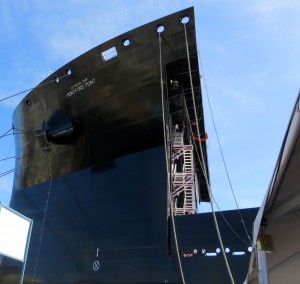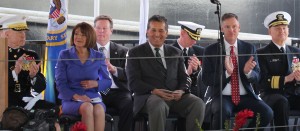2013-03-07 During the week prior to the christening of the new Mobile Landing Platform in San Diego, Second Line of Defense sat down with Rear Admiral Mark Buzby to discuss the role of the ship and the evolution of the seabase.
We have focused on several dynamic tools being added to the seabase creating new capabilities, ranging from aircraft (the Osprey and the F-35B) to ships (the USS America and the T-AKE) to new methods of working the seabase (new IT approaches). Here we discussed the upcoming visit to San Diego to witness the christening of the MLP.
The remarks, which Admiral Buzby delivered during the ceremony, can be found here:
Admiral Buzby Remarks at USNS Montford Point Christening as Written
SLD: We would like to discuss the new addition to the fleet, namely the USNS Montford Point. How are you going to use the ship?
Admiral Buzby: The USNS Montfort Point is our newest ship and it’s our newest type of ship. It’s a float on/float off ship that was basically conceived from an existing BP Alaska-class tanker design that we modified to give us a float on/float off capability that’s going to be essentially a pier at sea.
It’s going to integrate with the maritime prepositioning force that we currently have. These two squadrons of ships provide the ability to deliver a brigade’s worth of combat equipment and sustainment from large medium speed roll on/roll off ships in stream or inport. MLP enhances the in stream off load capability.

It will give us the capability to have connection to the beach to move the material off those LMSRs much quicker than we do today using lighterage that is typically carried on the MPS ships.
This will give us the capability to have a lot of throughput as it’s currently envisioned.
It’s a big empty deck, it’s 80,000 tons and 800 feet of use your imagination.
It’s a big empty deck from which you can put almost anything to move pretty much anywhere.
In other words, it gives us tremendous flexibility, of the kind, which is increasingly necessary in an uncertain world.
SLD: And looking at how the USN-USMC are looking at Pacific operations, the kind of flexibility is crucial to operate across the spectrum of demands as well. We are sure that this new ship will support the kind of flexibility being demonstrated by the USN-USMC team as well.
Admiral Buzby: I’m absolutely certain that we’re going to use that ship for things that we have not even envisioned yet.
It will carry cargos and it will carry equipment that’s not even been invented yet over the course of its 30 or 40 years that it will be in service.
And I think it’s part of the new generation of vessels—joint high-speed vessel being another one — that’s open, that’s flexible, that enables the War Fighter a lot more maneuver room than they had in the past. Earlier generations of vessels often constrained options because they were much more purpose built for specific action or specific mission.
These new ships have a wide-open mission and a wide-open ability to adapt to whatever it is, whether it’s a war-fighting mission; a more aggressive sort of mission, or whether it’s more of a humanitarian mission, or anything in between.
SLD: The seabasing approach is in the throes of significant change. Indeed, one could talk about the “disruptive change” associated with the evolving seabase. How do you look at what might be labeled the “seabasing revolution?”
Admiral Buzby: We’ve been talking about a sea base for a long time. And up until very recently, we have not had the proper assets to really bring that talk to a full reality. We did not have the capabilities that many of the planners and envision(ers) of sea basing thought would be necessary to really have a robust seabasing capability.
We’re now beginning to add new assets, such as the T-AKE ship and the mobile landing platform. These ships enable a lot of the connections to occur that were sort of missing before.

Prior to their arrival, the only connections that you had really were the LCACs and LCUs that were carried on the amphibious shipping. Or we used the MPS-carried Improved Navy Lighterage System (INLS) powered barges, which were slow, low sea-state capable systems where you had to be fairly close in to make that all work, and it was challenging to put all that together into a support package.
We’ve now introduced some capability with not only ships, but the aircraft and the MV-22 that’s able to operate from some of these sea-basing platforms. The T-AKE that’s now part of the maritime prepositioning force gives you the selectivity of offload that you didn’t have in the past, as well as freeing up cargo space in the other MPS hulls.
With these combinations of ships and with the addition of the new joint high-speed vessel, which is yet another connector, we are shaping a much more effective support capability from the sea. And without a whole lot more additions, you could make probably this sea base into a fairly robust entity that could stand in a higher threat environment than perhaps it does right now.
And with the new tools comes an ability to think differently.
The mix and matching of the new assets with the old will allow the evolving USN-USMC team to think differently about how to operate from the sea.
You now have lots of young officers who are thinking of new ways to kluge these assets together to do missions differently. We’re giving them the tools to think about operations differently.
SLD: The innovation being generated from the support side is somewhat unusual and allows innovation on the mission side as well. How odd is it to think of the MSC at the cutting edge of change?
Admiral Buzby: It’s casting MSC in a little bit of an unusual role because historically, we get the cast offs from the Navy. We get 20 and 30-year-old ships that are held together with bailing wire and we keep them going for another decade or so. We also get purpose-built new ships, and that is becoming more the norm these days.
But now we’re finding ourselves suddenly on the very leading edge doctrinally, with brand new gear, with brand new concepts, with brand new con-ops to not only just follow, but to develop ourselves.
That’s requiring a bit of a reorganization within the MSC community to re-evaluate how we do various missions and how we produce the required readiness; it’s a very dynamic and exciting time for what has been a steady state outfit for a long time.
SLD: With regard to the MLP, what is the next evolution of the ship that you would like to see?
Admiral Buzby: At 80,000 tons, it’s a big ship. And the limitations right now in my mind are going to be the instream skin-to-skin offload aspect.
If you were to invest and upgrade that ship with a dynamic positioning capability, which was once envisioned for the MLP, you wouldn’t need to moor ships side by side, you could just have them hover next to each other, even station-keep close aboard while transferring material.
We have already demonstrated a capability to position an articulated ramp between ships, which would be important in a high sea-state. So you could still do the transfer in a favorable direction and make a lee without getting into crunching the ships alongside each other. That sort of capability would broaden sea state operational limitations that we currently must deal with.

